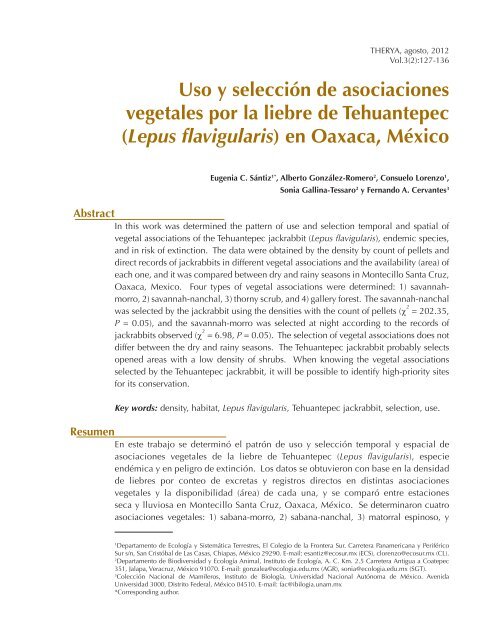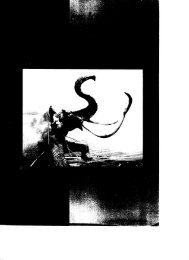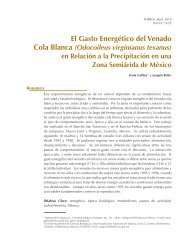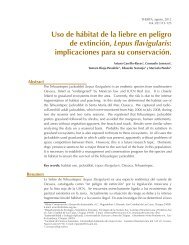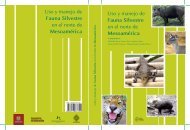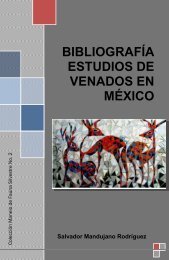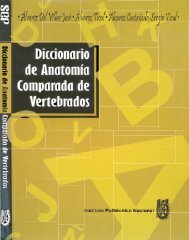Therya agosto 2012.indb - AMMAC: Acerca de la Asociación ...
Therya agosto 2012.indb - AMMAC: Acerca de la Asociación ...
Therya agosto 2012.indb - AMMAC: Acerca de la Asociación ...
Create successful ePaper yourself
Turn your PDF publications into a flip-book with our unique Google optimized e-Paper software.
Abstract<br />
Resumen<br />
THERYA, <strong>agosto</strong>, 2012<br />
Vol.3(2):127-136<br />
Uso y selección <strong>de</strong> asociaciones<br />
vegetales por <strong>la</strong> liebre <strong>de</strong> Tehuantepec<br />
(Lepus f<strong>la</strong>vigu<strong>la</strong>ris) en Oaxaca, México<br />
Eugenia C. Sántiz 1* , Alberto González-Romero 2 , Consuelo Lorenzo 1 ,<br />
Sonia Gallina-Tessaro 2 y Fernando A. Cervantes 3<br />
In this work was <strong>de</strong>termined the pattern of use and selection temporal and spatial of<br />
vegetal associations of the Tehuantepec jackrabbit (Lepus f<strong>la</strong>vigu<strong>la</strong>ris), en<strong>de</strong>mic species,<br />
and in risk of extinction. The data were obtained by the <strong>de</strong>nsity by count of pellets and<br />
direct records of jackrabbits in different vegetal associations and the avai<strong>la</strong>bility (area) of<br />
each one, and it was compared between dry and rainy seasons in Montecillo Santa Cruz,<br />
Oaxaca, Mexico. Four types of vegetal associations were <strong>de</strong>termined: 1) savannahmorro,<br />
2) savannah-nanchal, 3) thorny scrub, and 4) gallery forest. The savannah-nanchal<br />
was selected by the jackrabbit using the <strong>de</strong>nsities with the count of pellets (c 2 = 202.35,<br />
P = 0.05), and the savannah-morro was selected at night according to the records of<br />
jackrabbits observed (c 2<br />
= 6.98, P = 0.05). The selection of vegetal associations does not<br />
differ between the dry and rainy seasons. The Tehuantepec jackrabbit probably selects<br />
opened areas with a low <strong>de</strong>nsity of shrubs. When knowing the vegetal associations<br />
selected by the Tehuantepec jackrabbit, it will be possible to i<strong>de</strong>ntify high-priority sites<br />
for its conservation.<br />
Key words: <strong>de</strong>nsity, habitat, Lepus f<strong>la</strong>vigu<strong>la</strong>ris, Tehuantepec jackrabbit, selection, use.<br />
En este trabajo se <strong>de</strong>terminó el patrón <strong>de</strong> uso y selección temporal y espacial <strong>de</strong><br />
asociaciones vegetales <strong>de</strong> <strong>la</strong> liebre <strong>de</strong> Tehuantepec (Lepus f<strong>la</strong>vigu<strong>la</strong>ris), especie<br />
endémica y en peligro <strong>de</strong> extinción. Los datos se obtuvieron con base en <strong>la</strong> <strong>de</strong>nsidad<br />
<strong>de</strong> liebres por conteo <strong>de</strong> excretas y registros directos en distintas asociaciones<br />
vegetales y <strong>la</strong> disponibilidad (área) <strong>de</strong> cada una, y se comparó entre estaciones<br />
seca y lluviosa en Montecillo Santa Cruz, Oaxaca, México. Se <strong>de</strong>terminaron cuatro<br />
asociaciones vegetales: 1) sabana-morro, 2) sabana-nanchal, 3) matorral espinoso, y<br />
1 Departamento <strong>de</strong> Ecología y Sistemática Terrestres, El Colegio <strong>de</strong> <strong>la</strong> Frontera Sur. Carretera Panamericana y Periférico<br />
Sur s/n, San Cristóbal <strong>de</strong> Las Casas, Chiapas, México 29290. E-mail: esantiz@ecosur.mx (ECS), clorenzo@ecosur.mx (CL).<br />
2 Departamento <strong>de</strong> Biodiversidad y Ecología Animal, Instituto <strong>de</strong> Ecología, A. C. Km. 2.5 Carretera Antigua a Coatepec<br />
351, Ja<strong>la</strong>pa, Veracruz, México 91070. E-mail: gonzalea@ecologia.edu.mx (AGR), sonia@ecologia.edu.mx (SGT).<br />
3 Colección Nacional <strong>de</strong> Mamíferos, Instituto <strong>de</strong> Biología, Universidad Nacional Autónoma <strong>de</strong> México. Avenida<br />
Universidad 3000, Distrito Fe<strong>de</strong>ral, México 04510. E-mail: fac@ibilogia.unam.mx<br />
*Corresponding author.


